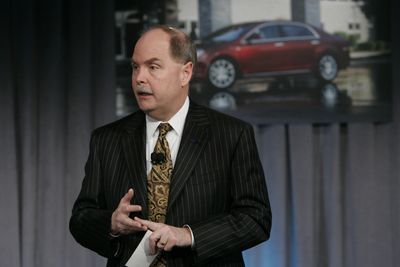New GM chief open to possible bankruptcy
Henderson acknowledges company efforts may fail

General Motors Corp. is prepared to enter bankruptcy if it cannot restructure by itself, the company’s new chief executive, Fritz Henderson, said Tuesday.
“Our preference is to do this outside a bankruptcy process,” said Henderson, in his first news conference since being named on Monday to lead the company. But “in the event that we need to, we will do it.”
Henderson was named chief executive after GM’s former leader, Rick Wagoner, was asked to step down by the Obama administration over the weekend.
On Monday, President Barack Obama announced his blueprint for restructuring GM and Chrysler, which have to date received a combined $17.4 billion from the U.S. government. He gave GM 60 days to resolve its structural problems and get on track to viability or face bankruptcy, while Chrysler now has 30 days to craft a merger with Italian automaker Fiat.
But Henderson said that the company would not need more than two months to resolve its outstanding problems, including renegotiating obligations to bondholders and the United Auto Workers union.
“More time isn’t going to help the process,” he said, suggesting that it would become readily apparent if the problems prove intractable. At that point, he said, bankruptcy may be the best option for the carmaker. The company had been “making contingency planning” for a bankruptcy filing even before Obama’s announcement, he said.
Henderson also said that GM would probably close more auto plants and further cut jobs as part of its restructuring efforts, but did not provide details.
Henderson’s remarks came as GM announced a new incentive plan designed to get car buyers back into dealer showrooms by offering to cover auto payments in case of job loss. Hours earlier, Ford Motor Co. revealed a similar plan. Ford has not received any federal loans.
“Consumers remain anxious about the economy and their own outlook for the future,” said Ken Czubay, Ford’s vice president of sales and marketing, adding that the payment protection plan was designed to “rebuild faith in the marketplace.”
GM said the incentive plan was intended to address what Henderson referred to as “the other side of the balance sheet”: sales and revenue.
Last year, GM’s U.S. sales declined nearly 23 percent, and Chrysler’s dropped 30 percent. In the first two months of this year, GM’s sales fell 51 percent while Chrysler’s were off 49 percent.
The Autos Task Force assembled by the Obama administration indicated this week that the sales fall-off was so deep that it invalidated the goals the automakers had set for themselves in restructuring plans submitted last month.
GM, for example, said it would need an annual industrywide U.S. sales rate of at least 10.5 million vehicles to get out of the red, yet in January and February, that rate was barely at 9 million.
By instituting the new incentives, GM and Ford appear to be responding to consumer needs in a deeply challenging marketplace, where confidence measures are at an all-time low.
“What we found was that traditional incentives just weren’t working,” said Mark LaNeve, GM’s North American head of sales and marketing, as he introduced the new incentive plan. He called it “far superior” to Hyundai’s Assurance program, which covers three payments in case of unemployment.